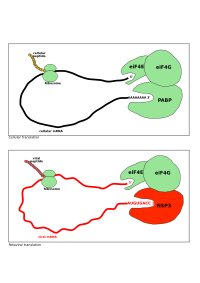.gif)
NSP3 (rotavirus)
Encyclopedia
Rotavirus
protein NSP3 (NS34) is bound to the 3' end consensus sequence of viral mRNAs
in infected cells.
Four nucleotides are the minimal requirement for RNA recognition by rotavirus non-structural protein NSP3: using short oligoribonucleotides, it was established that the minimal RNA sequence required for binding of NSP3A is GACC.
Rotavirus RNA-binding
protein NSP3 interacts with eIF4GI
and evicts the poly(A)-binding protein
from eIF4F
. And NSP3A, by taking the place of PABP on eIF4GI, is responsible for the shut-off of cellular protein synthesis.
Expression of NSP3 in mammalian cells allows the efficient translation
of virus-like mRNA: NSP3 forms a link between viral mRNA and the cellular translation machinery and hence is a functional analogue of cellular poly(A)-binding protein.
Site-directed mutagenesis and isothermal titration calorimetry documented that NSP3 and PABP use analogous eIF4G recognition strategies, despite marked differences in tertiary structure.
 Using the yeast two-hybrid assay, RoXan
Using the yeast two-hybrid assay, RoXan
a novel cellular protein was found to bind NSP3. The interaction between NSP3 and RoXaN does not impair the interaction between NSP3 and eIF4GI, and a ternary complex made of NSP3, RoXaN, and eIF4G I can be detected in rotavirus-infected cells, implicating RoXaN in translation regulation.
Rotavirus
Rotavirus is the most common cause of severe diarrhoea among infants and young children, and is one of several viruses that cause infections often called stomach flu, despite having no relation to influenza. It is a genus of double-stranded RNA virus in the family Reoviridae. By the age of five,...
protein NSP3 (NS34) is bound to the 3' end consensus sequence of viral mRNAs
Messenger RNA
Messenger RNA is a molecule of RNA encoding a chemical "blueprint" for a protein product. mRNA is transcribed from a DNA template, and carries coding information to the sites of protein synthesis: the ribosomes. Here, the nucleic acid polymer is translated into a polymer of amino acids: a protein...
in infected cells.
Four nucleotides are the minimal requirement for RNA recognition by rotavirus non-structural protein NSP3: using short oligoribonucleotides, it was established that the minimal RNA sequence required for binding of NSP3A is GACC.
Rotavirus RNA-binding
RNA-binding protein
RNA-binding proteins are proteins that bind to RNA. They bind to either double-strand or single-strand RNAs through RNA recognition motif . RNA-binding proteins may regulate the translation of RNA, and post-transcriptional events, such as RNA splicing, editing.They are cytoplasmic and nuclear...
protein NSP3 interacts with eIF4GI
Eukaryotic initiation factor
Eukaryotic initiation factors are proteins involved in the initiation phase of eukaryotic translation. They function in forming a complex with the 40S ribosomal subunit and Met-tRNAi called the 43S preinitation complex , recognizing the 5' cap structure of mRNA and recruiting the 43S PIC to mRNA,...
and evicts the poly(A)-binding protein
Poly(A)-binding protein
Poly-binding protein is a RNA-binding protein which binds to the poly tail of mRNA. The poly tail is located on the 3' end of mRNA...
from eIF4F
Eukaryotic initiation factor
Eukaryotic initiation factors are proteins involved in the initiation phase of eukaryotic translation. They function in forming a complex with the 40S ribosomal subunit and Met-tRNAi called the 43S preinitation complex , recognizing the 5' cap structure of mRNA and recruiting the 43S PIC to mRNA,...
. And NSP3A, by taking the place of PABP on eIF4GI, is responsible for the shut-off of cellular protein synthesis.
Expression of NSP3 in mammalian cells allows the efficient translation
Rotavirus translation
Rotavirus translation, the process of translating mRNA into proteins, occurs in a different way in Rotaviruses. Unlike the vast majority of cellular proteins in other organisms, in Rotaviruses the proteins are translated from capped but nonpolyadenylated mRNAs...
of virus-like mRNA: NSP3 forms a link between viral mRNA and the cellular translation machinery and hence is a functional analogue of cellular poly(A)-binding protein.
Site-directed mutagenesis and isothermal titration calorimetry documented that NSP3 and PABP use analogous eIF4G recognition strategies, despite marked differences in tertiary structure.

Roxan (protein)
RoXaN also known as ZC3H7B , is a protein that in humans is encoded by the ZC3H7B gene. RoXaN is a protein that contains tetratricopeptide repeat and leucine-aspartate repeat as well as zinc finger domains...
a novel cellular protein was found to bind NSP3. The interaction between NSP3 and RoXaN does not impair the interaction between NSP3 and eIF4GI, and a ternary complex made of NSP3, RoXaN, and eIF4G I can be detected in rotavirus-infected cells, implicating RoXaN in translation regulation.

